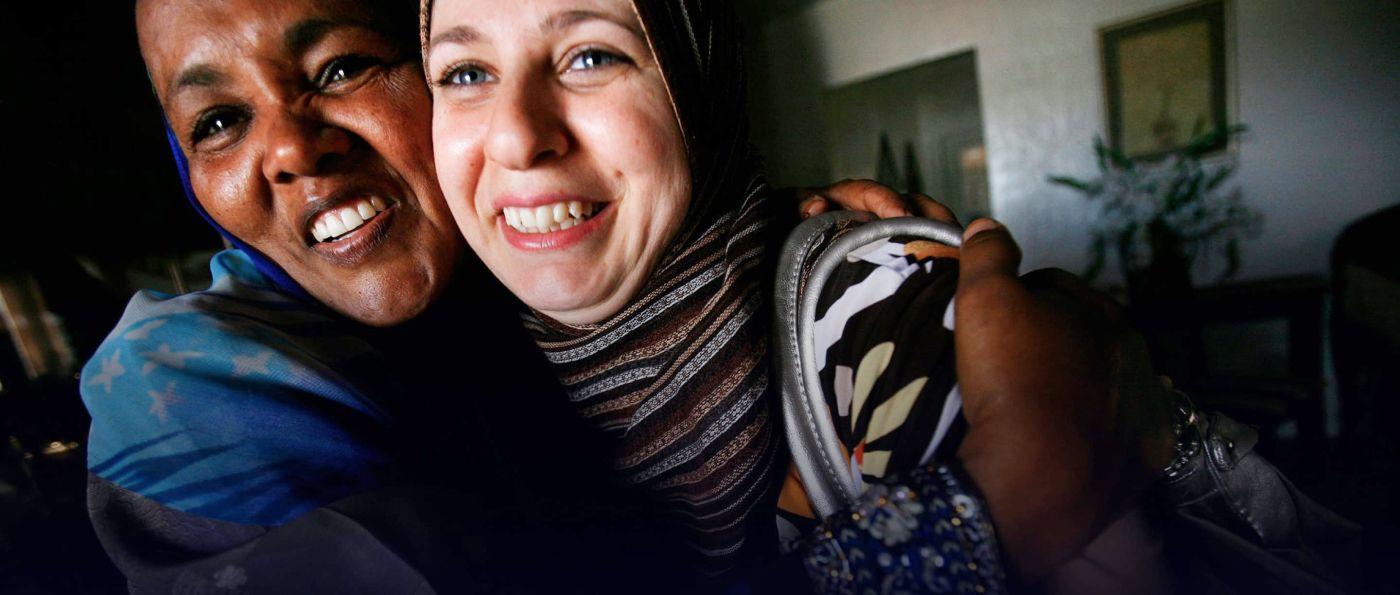Newcomers and Sponsorship 101

Less than 1% of people who are forced to flee their homes globally are ever resettled, and an even smaller portion eventually finds safety in the U.S. Only a subset of that population comes to the U.S. because they are sponsored by American sponsors who are motivated by their care and compassion to help someone in need.
This resource explores the journey that sponsored newcomers take to come to the U.S. and the two historic sponsorship pathways available to qualified individuals seeking safety from violence or persecution: refugee resettlement and humanitarian parole.
Learn more about these statuses and processes
Refugee resettlement 101
In this section, we explore what it means to be a refugee, both the legal status and as a lived human experience. We'll examine how international protection systems work, what rights refugees hold, and how resettlement processes unfold.
Visit the refugee resettlement 101 siteHumanitarian parole 101
This section explains humanitarian parole, its purpose, and its operation. We also examine the legal framework behind parole, the eligibility criteria, and its implications for people navigating crises with few options and little time.
Visit the humanitarian parole 101 siteBy the numbers
Click through the drop-down sections below to learn more about some of the numbers behind refugees and humanitarian parolees.
Refugees by the numbers
(as of October 4, 2024)
See the UNHCR’s website for more refugee statistics.
- There are over 47.7 million refugees in the world under UNHCR’s mandate.
- 71% are hosted in low- and middle-income countries.
- 69% are hosted in neighbouring countries.
- 3 million refugees have resettled in the United States since 1975.
- 65% of refugees worldwide originate from just four countries: Syria, Venezuela, Ukraine, and Afghanistan
- Iran, Turkey, Colombia, Germany, and Uganda host the most refugees (about 32% of all refugee populations).
Humanitarian parolees by the numbers
See IRAP’s website and NFAP’s brief for more humanitarian parole statistics.
- Since 2021, almost 1 million newcomers have been granted humanitarian parole status, coming from Afghanistan, Cuba, Haiti, Nicaragua, Ukraine, and Venezuela.
- Americans have welcomed newcomers in all 50 states across 12,000 zip codes.
- More than 2 million Americans raised their hands to serve as private community sponsors for refugee newcomers in need of safety.
Did you know that in 2022 alone, immigrant households paid $579.1 billion in total taxes?
Newcomers play a key role in strengthening both our economy and our communities. They fill workforce gaps, start businesses, and contribute billions of dollars in taxes. At the same time, they bring cultural diversity, revitalize neighborhoods, and engage actively in civic life—making our communities stronger and more connected.
Learn more about the impacts of newcomers
How do newcomers benefit my community’s economy?
Newcomers strengthening the workforce
- 19% of the U.S. workforce includes immigrants and refugees¹
- In 2022 alone, immigrant households paid $579.1 billion in total taxes—nearly one in every six tax dollars collected by federal, state, and local governments.²
- Newcomers fill labor shortages and support industries in need of workers³ For example, 15.6% of all nurses and 27.7% of all health aides are immigrants, 54.3% of graders and sorters of agricultural products are immigrants, as are 25.3% of workers in the agriculture industry overall.
Newcomers drive economic growth
- The Congressional Budget Office (CBO) estimates that the greater level of immigration expected between 2024 and 2034 will boost gross domestic product (GDP) by $8.9 trillion. ⁴
- From 2005 to 2019, refugees and asylees generated a net fiscal benefit of $123.8 billion to the U.S. governmen ⁵
Newcomers create jobs and businesses
- Newcomers start businesses, create jobs, and invest in local communities. For example, in 2019, immigrant entrepreneurs made up 21.7 percent of all business owners in the United States. In 2017, 8 million people were employed by immigrant-owned businesses, and total sales of immigrant-owned businesses in 2017 were $1.3 trillion.⁶
- Their innovation and entrepreneurship strengthen the economy for everyone. For example, Forbes finds immigrants have founded or co-founded nearly two-thirds (65% or 28 of 43) of the top AI companies in the United States, and 55% of America’s startup companies valued at $1 billion or more had at least one immigrant founder.⁷
How do newcomers enrich my community?
Newcomers bring diverse cultures, traditions, and languages
- 350+ languages are spoken in U.S. homes⁸
- Cultural diversity boosts innovation by 60% and problem-solving effectiveness by 87% in workplaces and communities⁹
Newcomers engage in their communities
- Newcomers become engaged neighbors and active volunteers in our communities, contributing at equal or higher rates than U.S.-born residents. For example, 46% of all Fortune 500 companies were founded by immigrants or their children. ¹⁰
- The American Immigration Council finds that 13 percent of refugees are entrepreneurs, compared to just 11.7 percent of non-refugee immigrants and 9 percent of the U.S.born population.¹¹
Understanding common U.S. immigration statuses

What is the difference between refugee status, humanitarian parole, asylum, and Temporary Protected Status?
See the USCIS website for more definitions and information.
Refugees are admitted from outside the United States due to persecution based on race, religion, nationality, political opinion, or social group membership, receiving legal status upon entry and eligibility for permanent residency after one year.
In contrast, asylum seekers arrive in the U.S. first (often at the border or already within the country), and then apply for protection.
An individual who enters the U.S. through humanitarian parole is allowed in the country temporarily for urgent humanitarian reasons or significant public benefit andmust find another legal pathway, such as asylum or family sponsorship, to remain in the U.S. long-term or seek citizenship.
Temporary Protected Status (TPS) allows people already in the U.S. from crisis-affected countries to live and work legally for limited periods, requiring regular renewal and alternative pathways for permanent status.

Recent policy changes
For up-to-date information and expert guidance on recent changes to sponsorship pathways and our welcoming communities in 2025, visit our policy updates page.


